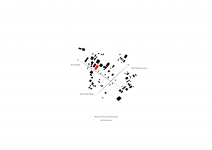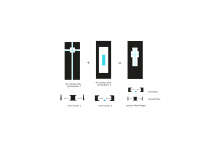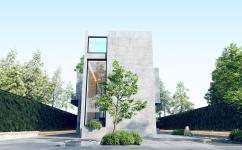First we want to learn how to see what was not present in a building. In this project we do not want to describe what audience could actually see. Rather, we want to see what ideas were implied by what was physically present. In other words, we are less concerned about the optical, what the eye sees, and more for the visual, what the mind sees. So “seeing with the mind” is the main intention.
This project discovers a moment in architecture in which there is an acknowledgment of the past, then breaks with the past, and finally links with a speculative of possible future. Although this building is not self-sufficient, it is based on eastern philosophy and becomes an autonomous form.
Inspired by the pattern of Iranian gardens and the study of their evolution, axes have been created which pavilion have appeared as the intersection of those axes. Two different types (contain garden and content garden) for the Persian garden combined and duplicated in two levels of the project and create a whole unit as an abstract shape of the modern garden which its outward references, did not make it conditional on external factors. Creating similarities with the architecture of Iranian gardens means reduction based on its deep structure. Behold a work of architecture means to improve the public audience gusto when encounter it as an outlandish building in Torkamandeh village. This is similar to what happens to a prominent music listener, who has the ability to distinguish valuable sounds from annoying.
In the northeast mountains of Tehran where tranquility and pristine nature replace with pollution and congestion of capital, provides an opportunity for residents of Tehran to move to this place for leisure a few days a year, so essentially this area is sparsely populated.
DehTorkaman is a village located near Khojir National Park where considered as one of the most important contexts of valuable flora and fauna. Therefore, any action for the development of the village should be done taking its physical-geographical factors into consideration. The position of the site in the topography is such that it is at the highest level to its surroundings.
The aim of extensive roof garden is to compensate the area that the building has taken away from nature. In fact, the green area is duplicated at the height. The house is designed for a modern family situated in the highest level of the village. So the openings are based on unique views.The design is developed to screen this Mountainous context, while simultaneously takes the historical and modern guidelines that govern the shape and placement of spaces, water and courts, the orientation of water path, pool and choice of colors.
2020
2020
Project name: Torkamandeh villa
• Architecture firm: saeed shenakhteh studio
• Principal architect: Saeed Shenakhteh
• Project location: Deh Torkaman- Tehran- Iran
• Built area: 560 m2
• Site area: 1000 m2
• Photography:
• Visualization: Saeed Shenakhteh
• Tools used: software used for drawing, modeling, rendering, postproduction and photography:
Modeling: revit
Rendering: Vray 3Dmax
Post production: Photoshop
• Design team: Samin Eshraghi- Erfan Javahery
• Collaborators:
• Interior design: Saeed Shenakhteh
• Design year: 2020
• Materials: concrete
• Client: Mr. Ramezanpour
• Status: unbuilt
• Typology: Villa
samin eshraqi
erfan javaheri




















